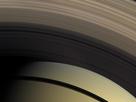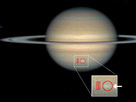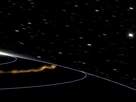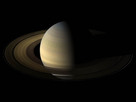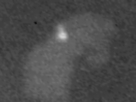PASADENA, Calif.
Saturn Propellers Reflect Solar System Origins
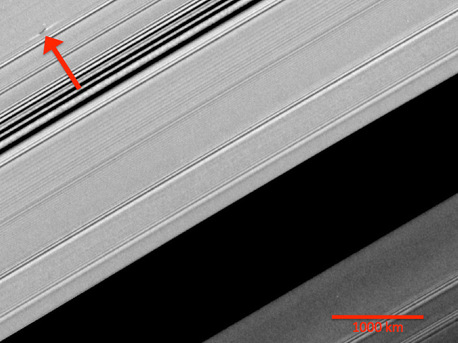 © NASA/JPL/SSI
|
A propeller-shaped structure created by an unseen moon appears dark in this image obtained by NASA's Cassini spacecraft of the unilluminated side of Saturn's rings.
The results are published in a new study in the July 8, 2010, issue of the journal Astrophysical Journal Letters.
Cassini scientists first discovered double-armed propeller features in 2006 in an area now known as the "propeller belts" in the middle of Saturn's outermost dense ring, known as the A ring. The spaces were created by a new class of moonlets - smaller than known moons, but larger than the particles in the rings - that could clear the space immediately around them. Those moonlets, which were estimated to number in the millions, were not large enough to clear out their entire path around Saturn, as do the moons Pan and Daphnis.
The new paper, led by Matthew Tiscareno, a Cassini imaging team associate based at Cornell University, Ithaca, N.Y., reports on a new cohort of larger and rarer moons in another part of the A ring farther out from Saturn. With propellers as much as hundreds of times as large as those previously described, these new objects have been tracked for as long as four years.
The propeller features are up to several thousand kilometers (miles) long and several kilometers (miles) wide. The moons embedded in the ring appear to kick up ring material as high as 0.5 kilometers (1,600 feet) above and below the ring plane, which is well beyond the typical ring thickness of about 10 meters (30 feet). Cassini is too far away to see the moons amid the swirling ring material around them, but scientists estimate that they are about a kilometer (half a mile) in diameter because of the size of the propellers.
Tiscareno and colleagues estimate that there are dozens of these giant propellers, and 11 of them were imaged multiple times between 2005 to 2009. One of them, nicknamed Bleriot after the famous aviator Louis Bleriot, has been a veritable Forrest Gump, showing up in more than 100 separate Cassini images and one ultraviolet imaging spectrograph observation over this time.
"Scientists have never tracked disk-embedded objects anywhere in the universe before now," Tiscareno said. "All the moons and planets we knew about before orbit in empty space. In the propeller belts, we saw a swarm in one image and then had no idea later on if we were seeing the same individual objects. With this new discovery, we can now track disk-embedded moons individually over many years."
Over the four years, the giant propellers have shifted their orbits, but scientists are not yet sure what is causing the disturbances in their travels around Saturn. Their path may be upset by bumping into other smaller ring particles, or responding to their gravity, but the gravitational attraction of large moons outside the rings may also be a factor. Scientists will continue monitoring the moons to see if the disk itself is driving the changes, similar to the interactions that occur in young solar systems. If it is, Tiscareno said, this would be the first time such a measurement has been made directly.
"Propellers give us unexpected insight into the larger objects in the rings," said Linda Spilker, Cassini project scientist based at NASA's Jet Propulsion Laboratory in Pasadena, Calif. "Over the next seven years, Cassini will have the opportunity to watch the evolution of these objects and to figure out why their orbits are changing."
The Cassini-Huygens mission is a cooperative project of NASA, the European Space Agency and the Italian Space Agency. The Jet Propulsion Laboratory, a division of the California Institute of Technology in Pasadena, manages the Cassini-Huygens mission for NASA's Science Mission Directorate in Washington. The Cassini orbiter and its two onboard cameras were designed, developed and assembled at JPL. The imaging operations center is based at the Space Science Institute in Boulder, Colo.
Source: NASA
PASADENA, Calif.
Saturn Propellers Reflect Solar System Origins
 © NASA/JPL/SSI
|
A propeller-shaped structure created by an unseen moon appears dark in this image obtained by NASA's Cassini spacecraft of the unilluminated side of Saturn's rings.
The results are published in a new study in the July 8, 2010, issue of the journal Astrophysical Journal Letters.
Cassini scientists first discovered double-armed propeller features in 2006 in an area now known as the "propeller belts" in the middle of Saturn's outermost dense ring, known as the A ring. The spaces were created by a new class of moonlets - smaller than known moons, but larger than the particles in the rings - that could clear the space immediately around them. Those moonlets, which were estimated to number in the millions, were not large enough to clear out their entire path around Saturn, as do the moons Pan and Daphnis.
The new paper, led by Matthew Tiscareno, a Cassini imaging team associate based at Cornell University, Ithaca, N.Y., reports on a new cohort of larger and rarer moons in another part of the A ring farther out from Saturn. With propellers as much as hundreds of times as large as those previously described, these new objects have been tracked for as long as four years.
The propeller features are up to several thousand kilometers (miles) long and several kilometers (miles) wide. The moons embedded in the ring appear to kick up ring material as high as 0.5 kilometers (1,600 feet) above and below the ring plane, which is well beyond the typical ring thickness of about 10 meters (30 feet). Cassini is too far away to see the moons amid the swirling ring material around them, but scientists estimate that they are about a kilometer (half a mile) in diameter because of the size of the propellers.
Tiscareno and colleagues estimate that there are dozens of these giant propellers, and 11 of them were imaged multiple times between 2005 to 2009. One of them, nicknamed Bleriot after the famous aviator Louis Bleriot, has been a veritable Forrest Gump, showing up in more than 100 separate Cassini images and one ultraviolet imaging spectrograph observation over this time.
"Scientists have never tracked disk-embedded objects anywhere in the universe before now," Tiscareno said. "All the moons and planets we knew about before orbit in empty space. In the propeller belts, we saw a swarm in one image and then had no idea later on if we were seeing the same individual objects. With this new discovery, we can now track disk-embedded moons individually over many years."
Over the four years, the giant propellers have shifted their orbits, but scientists are not yet sure what is causing the disturbances in their travels around Saturn. Their path may be upset by bumping into other smaller ring particles, or responding to their gravity, but the gravitational attraction of large moons outside the rings may also be a factor. Scientists will continue monitoring the moons to see if the disk itself is driving the changes, similar to the interactions that occur in young solar systems. If it is, Tiscareno said, this would be the first time such a measurement has been made directly.
"Propellers give us unexpected insight into the larger objects in the rings," said Linda Spilker, Cassini project scientist based at NASA's Jet Propulsion Laboratory in Pasadena, Calif. "Over the next seven years, Cassini will have the opportunity to watch the evolution of these objects and to figure out why their orbits are changing."
The Cassini-Huygens mission is a cooperative project of NASA, the European Space Agency and the Italian Space Agency. The Jet Propulsion Laboratory, a division of the California Institute of Technology in Pasadena, manages the Cassini-Huygens mission for NASA's Science Mission Directorate in Washington. The Cassini orbiter and its two onboard cameras were designed, developed and assembled at JPL. The imaging operations center is based at the Space Science Institute in Boulder, Colo.
Source: NASA






